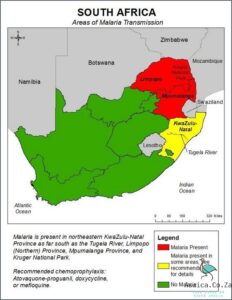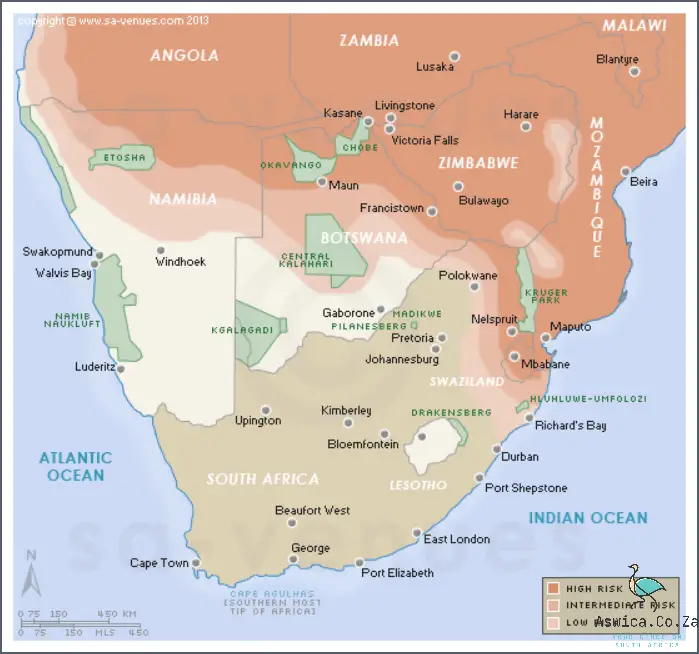
Malaria is a serious and life-threatening disease caused by a parasite that is transmitted to people through the bites of infected mosquitoes. Malaria is widespread in tropical and subtropical regions of the world, including parts of the Americas, Asia, and Africa.
Malaria Alert South Africa is a project of the South African National Department of Health, supported by the World Health Organization and the United States Centers for Disease Control and Prevention. The goal of the project is to reduce the burden of malaria in South Africa through surveillance, prevention, and treatment activities.
The project uses a variety of strategies to achieve its goals, including mosquito control, early diagnosis and treatment of malaria cases, and education and awareness-raising activities.
Contents
Malaria Alert South Africa
Malaria is a major public health concern in South Africa, with the highest number of cases in the world. The South African government is taking steps to control the spread of malaria by providing resources for early detection and treatment. Through various public health campaigns, people are being made aware of the dangers of malaria, and how to prevent it. Mosquito nets, insecticides, and other prevention methods are being widely distributed to protect people from being infected. Additionally, the government has been rolling out rapid diagnostic tests to diagnose the disease quickly in clinics and health centers, so that treatment can begin as soon as possible. The South African government is continuing its efforts to make sure that people are safe and malaria-free.
Overview of Malaria in South Africa
Malaria is a major public health concern in South Africa. In recent years, the number of cases of malaria in the country has been on the rise, and the disease is increasingly presenting new challenges for the country’s health care system. This article will provide an overview of malaria in South Africa, including its prevalence, causes, and potential solutions.
The prevalence of malaria in South Africa has been increasing in recent years, with the number of malaria cases rising from 1,500 in 2011 to over 13,000 in 2017. The highest concentration of cases are found in the Limpopo and Mpumalanga provinces, where the disease is endemic. Malaria is also commonly found in the Northern Cape, Free State and KwaZulu-Natal provinces.

The primary cause of malaria in South Africa is the Anopheles mosquito. These mosquitos become infected when they bite an infected person and then transmit the disease when they bite another person. The Anopheles mosquito is most active during the warmer months, which is why the malaria season in South Africa typically begins in October and ends in April.
In order to combat the spread of malaria, South Africa has implemented a number of measures to reduce the number of cases. These include actively treating infected patients with antimalarial drugs, distributing bed nets to those at risk, and spraying insecticides to reduce the number of mosquitos in affected areas. These efforts have been successful in reducing the number of malaria cases in the country, but more needs to be done in order to ensure that the disease does not continue to spread.
Malaria is a serious public health issue that needs to be addressed in South Africa. The country has implemented a number of measures to reduce the number of cases, but there is still more work to be done. With continued efforts, South Africa can make progress in reducing the spread of malaria and ensuring that people are able to live healthy lives.
Causes of Malaria in South Africa
Malaria is a major public health concern in South Africa, with the number of cases rising steadily over the years. The disease is caused by parasites that are transmitted to humans through the bites of infected female Anopheles mosquitoes. In South Africa, the most significant cause of malaria is the Anopheles funestus mosquito, which is responsible for 75% of all cases.
There are a variety of factors that contribute to the rise of malaria in South Africa. One of the most significant is the fact that the country is located in a tropical and subtropical region, which provides an ideal climate for mosquitoes to breed and thrive. Additionally, many parts of South Africa lack adequate infrastructure and resources to control mosquito populations, which further contributes to the spread of the disease.
A lack of access to health care and prevention measures is also a major contributor to the increased prevalence of malaria in South Africa. Common prevention measures such as the use of bed nets, insecticides, and insect repellents are not widely available to those living in poverty, resulting in greater vulnerability to the disease. In addition, the socio-economic disparities between those living in rural and urban areas mean that access to health care is often limited in rural areas, where the disease is most prevalent.
The prevalence of malaria in South Africa is also closely linked to the country’s high levels of poverty. Those living in poverty are often more likely to be exposed to the disease, as they do not have the resources to access preventative measures such as bed nets and insecticides. Additionally, poverty can lead to overcrowding, which further increases the risk of transmission.

Finally, South Africa’s climate and geography have a major influence on the prevalence of malaria in the country. The country’s high temperatures and humid climate create a perfect breeding ground for mosquitoes, while the wide-open plains and marshlands provide ideal habitats for the Anopheles funestus mosquito.
Overall, there are a number of factors that contribute to the rise of malaria in South Africa, including the prevalence of the Anopheles funestus mosquito, a lack of access to health care and preventative measures, high levels of poverty, and a conducive climate and geography. It is essential that measures are taken to address these factors in order to reduce the prevalence of the disease and its negative effects on the population.
Prevention and Treatment of Malaria in South Africa
Malaria is a serious and potentially life-threatening disease that is endemic to South Africa. The disease is caused by a parasite that is transmitted through the bite of an infected mosquito. Malaria can cause fever, chills, and flu-like symptoms, and can be fatal if not treated promptly. Fortunately, there are a number of prevention and treatment measures that can help to reduce the risk of malaria in South Africa.
Prevention is the best way to protect against malaria. South African residents should take steps to protect themselves from mosquitoes, such as using insect repellent, wearing long-sleeved shirts and long pants when outdoors, and sleeping in air-conditioned or well-screened rooms. Additionally, travelers to areas where malaria is present should take anti-malarial medications prior to, during, and after their trip.
In South Africa, malaria treatment is available for those who develop the disease. Treatment typically consists of a course of antimalarial drugs, which can be taken orally or intravenously. It is important to begin treatment as soon as possible after the onset of symptoms, as this will help to reduce the severity of the illness and prevent complications.
Additionally, South African public health officials are working to reduce the incidence of malaria in the country. This includes increased vector control efforts, such as the use of insecticide-treated bed nets and indoor residual spraying. Public health campaigns are also used to educate the public about the dangers of malaria and how to prevent it.
Malaria is a serious and potentially life-threatening disease, but with proper prevention and treatment, the risk of malaria in South Africa can be reduced. By taking preventive measures and seeking prompt treatment if symptoms occur, South African residents and travelers can help to protect themselves against this dangerous disease.
Conclusion
Malaria Alert South Africa is an initiative by the South African National Department of Health, in partnership with the World Health Organization and other partners, to improve the detection and response to malaria outbreaks in the country. The initiative includes the development of a national malaria surveillance system, the establishment of a national malaria rapid response team, and the provision of training and support to health care workers.




